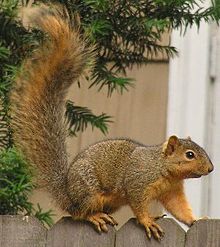Squirrels use 'chunking'
to organize their favorite nuts
University of
California - Berkeley
 Like trick-or-treaters
sorting their Halloween candy haul, fox squirrels apparently organize their
stashes of nuts by variety, quality and possibly even preference, according to
new UC Berkeley research.
Like trick-or-treaters
sorting their Halloween candy haul, fox squirrels apparently organize their
stashes of nuts by variety, quality and possibly even preference, according to
new UC Berkeley research.
The study, published
in the Royal Society Open Science journal, is the first to
show evidence of squirrels arranging their bounty using "chunking," a
cognitive strategy in which humans and other animals organize spatial,
linguistic, numeric or other information into smaller more manageable
collections, such as subfolders on a computer.
Fox squirrels
stockpile at least 3,000 to 10,000 nuts a year and, under certain conditions,
separate each cache into quasi "subfolders," one for each type of
nut, researchers said.
 "This is the
first demonstration of chunking in a scatter-hoarding animal, and also suggests
that squirrels use flexible strategies to store food depending on how they
acquire food," said study lead author Mikel Delgado, a post-doctoral
researcher who conducted the study along with UC Berkeley psychology professor
Lucia Jacobs.
"This is the
first demonstration of chunking in a scatter-hoarding animal, and also suggests
that squirrels use flexible strategies to store food depending on how they
acquire food," said study lead author Mikel Delgado, a post-doctoral
researcher who conducted the study along with UC Berkeley psychology professor
Lucia Jacobs.
Presumably,
sophisticated caching techniques maximize the squirrels' ability to remember
where they've stored their most prized treats while at the same time hiding
them from potential pilferers, the researchers said.
"Squirrels may
use chunking the same way you put away your groceries. You might put fruit on
one shelf and vegetables on another. Then, when you're looking for an onion,
you only have to look in one place, not every shelf in the kitchen," said
study senior author Jacobs.
Over a two-year
period, the research team tracked the caching patterns of 45 male and female
fox squirrels as the reddish gray, bushy-tailed rodents buried almonds, pecans,
hazelnuts and walnuts in various wooded locations on the UC Berkeley campus.
The study used
combinations of locations and nut sequences on various groups of fox squirrels.
In one experiment, for example, each of the squirrels were fed 16 nuts, one
after another, under two separate conditions:
Some were fed at the locale where
they had cached the previous nut fed to them while others were fed at one
central location, to which they would need to return if they wanted another
nut.
Researchers gave some
squirrels 16 nuts in rows of four, say, almonds followed by pecans, followed by
hazelnuts and then walnuts, while others received 16 nuts in random order.
Using hand-held GPS
navigators, researchers tracked the squirrels from their starting location to
their caching location, then mapped the distribution of nut types and caching
locations to detect patterns.
They found that the
squirrels who foraged at a single location frequently organized their caches by
nut species, returning to, say, the almond area, if that was the type of nut
they were gathering, and keeping each category of nut that they buried separate.
Meanwhile, the squirrels foraging in multiple locations deliberately avoided caching in areas where they had already buried nuts, rather than organizing nuts by type.
Meanwhile, the squirrels foraging in multiple locations deliberately avoided caching in areas where they had already buried nuts, rather than organizing nuts by type.
"These
observations suggest that when lacking the cognitive anchor of a central food
source, fox squirrels utilize a different and perhaps simpler heuristic
(problem-solving).”